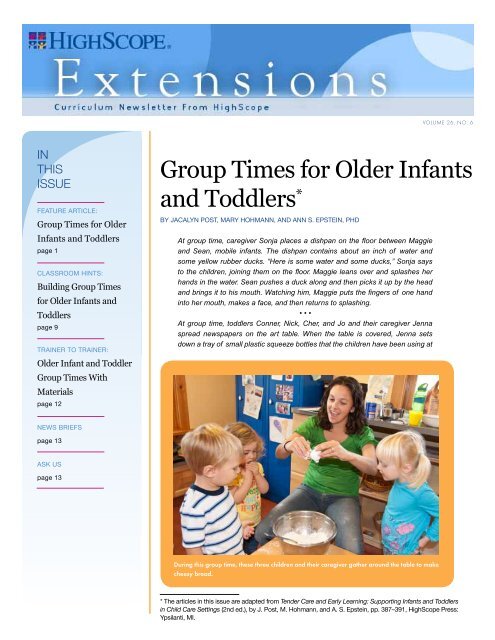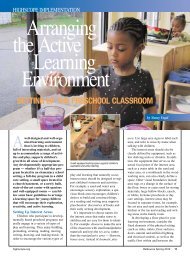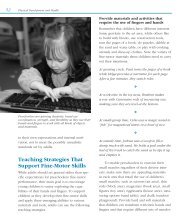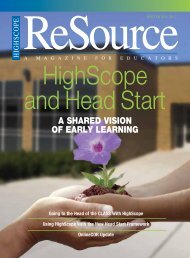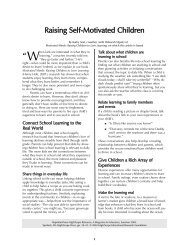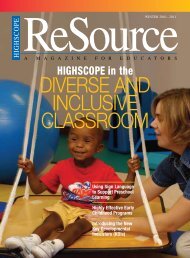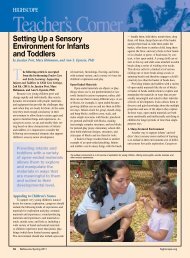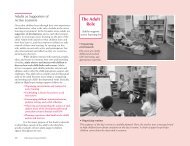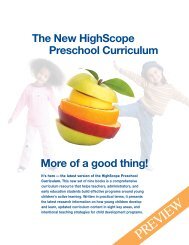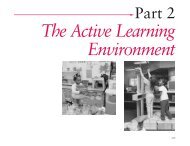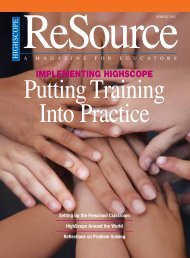Group Times for Older Infants and Toddlers* - High/Scope ...
Group Times for Older Infants and Toddlers* - High/Scope ...
Group Times for Older Infants and Toddlers* - High/Scope ...
You also want an ePaper? Increase the reach of your titles
YUMPU automatically turns print PDFs into web optimized ePapers that Google loves.
In<br />
ThIs<br />
Issue<br />
FEATURE ARTICLE:<br />
<strong>Group</strong> <strong>Times</strong> <strong>for</strong> <strong>Older</strong><br />
<strong>Infants</strong> <strong>and</strong> Toddlers<br />
page 1<br />
CLASSROOM HINTS:<br />
Building <strong>Group</strong> <strong>Times</strong><br />
<strong>for</strong> <strong>Older</strong> <strong>Infants</strong> <strong>and</strong><br />
Toddlers<br />
page 9<br />
TRAINER TO TRAINER:<br />
<strong>Older</strong> Infant <strong>and</strong> Toddler<br />
<strong>Group</strong> <strong>Times</strong> With<br />
Materials<br />
page 12<br />
NEWS BRIEFS<br />
page 13<br />
ASK US<br />
page 13<br />
VOLUME 26, NO. 6<br />
<strong>Group</strong> <strong>Times</strong> <strong>for</strong> <strong>Older</strong> <strong>Infants</strong><br />
<strong>and</strong> Toddlers *<br />
By JACALyN POST, MARy HOHMANN, ANd ANN S. EPSTEIN, PHd<br />
At group time, caregiver Sonja places a dishpan on the floor between Maggie<br />
<strong>and</strong> Sean, mobile infants. The dishpan contains about an inch of water <strong>and</strong><br />
some yellow rubber ducks. “Here is some water <strong>and</strong> some ducks,” Sonja says<br />
to the children, joining them on the floor. Maggie leans over <strong>and</strong> splashes her<br />
h<strong>and</strong>s in the water. Sean pushes a duck along <strong>and</strong> then picks it up by the head<br />
<strong>and</strong> brings it to his mouth. Watching him, Maggie puts the fingers of one h<strong>and</strong><br />
into her mouth, makes a face, <strong>and</strong> then returns to splashing.<br />
• • •<br />
At group time, toddlers Conner, Nick, Cher, <strong>and</strong> Jo <strong>and</strong> their caregiver Jenna<br />
spread newspapers on the art table. When the table is covered, Jenna sets<br />
down a tray of small plastic squeeze bottles that the children have been using at<br />
During this group time, these three children <strong>and</strong> their caregiver gather around the table to make<br />
cheesy bread.<br />
* The articles in this issue are adapted from Tender Care <strong>and</strong> Early Learning: Supporting <strong>Infants</strong> <strong>and</strong> Toddlers<br />
in Child Care Settings (2nd ed.), by J. Post, M. Hohmann, <strong>and</strong> A. S. Epstein, pp. 387–391, <strong>High</strong><strong>Scope</strong> Press:<br />
ypsilanti, MI.
<strong>Group</strong> <strong>Times</strong> <strong>for</strong> <strong>Older</strong> <strong>Infants</strong> <strong>and</strong> Toddlers, continued<br />
PUBLISHER CREDITS<br />
<strong>High</strong><strong>Scope</strong> Extensions is a practical resource <strong>for</strong> early<br />
childhood teachers, trainers, administrators, <strong>and</strong> child care<br />
providers. It contains useful in<strong>for</strong>mation on the <strong>High</strong><strong>Scope</strong><br />
Curriculum <strong>and</strong> on <strong>High</strong><strong>Scope</strong>’s training network.<br />
Jennifer Burd<br />
Joanne Tangorra<br />
Marcella Fecteau Weiner<br />
Editors<br />
Katie Bruckner<br />
Assistant Editor/Assistant Web Specialist<br />
Nancy Brickman<br />
Director of Publications<br />
Clara Trent<br />
Marketing Specialist<br />
Sherry Barker<br />
Membership Manager<br />
Kathleen Woodard<br />
Director of Marketing <strong>and</strong> Communication<br />
Produced by <strong>High</strong><strong>Scope</strong> Press, a division of <strong>High</strong><strong>Scope</strong><br />
Educational Research Foundation<br />
ISSN 2155-3548<br />
©2012 <strong>High</strong><strong>Scope</strong> Foundation<br />
The <strong>High</strong><strong>Scope</strong> Foundation is an independent, nonprofit<br />
organization founded by David Weikart in Ypsilanti, MI<br />
in 1970.<br />
the water table. “Here are some bottles of dribble salt <strong>for</strong> you to squeeze,”<br />
she says to the children. Conner selects a bottle, shakes it, turns it upside<br />
down, <strong>and</strong> squeezes it with both h<strong>and</strong>s. Jenna tries the same actions with<br />
a bottle she selects, <strong>and</strong> Nick watches Conner. Noticing Nick watching him,<br />
Conner takes another bottle, sets it down in front of Nick, <strong>and</strong> says “Bottle?”<br />
Nick simply looks at the bottle. “Nick, it looks like Conner is giving you a<br />
bottle to squeeze,” Jenna interprets. Taking the bottle, Nick squeezes it as<br />
Conner did, then sticks a finger into the resulting pool of dribble, licks his<br />
finger, <strong>and</strong> makes a face. Jenna follows suit, sticking her finger into the<br />
dribble she has squeezed out <strong>and</strong> then tasting it. She comments to Nick, “It<br />
tastes salty.”<br />
Cher <strong>and</strong> Jo dribble salt from their bottles while moving their arms back <strong>and</strong><br />
<strong>for</strong>th. Jenna tries moving her arms the same way. As Conner <strong>and</strong> Nick continue<br />
to squeeze their bottles <strong>and</strong> muck about, Cher <strong>and</strong> Jo leave the table,<br />
wash their h<strong>and</strong>s at the sink, <strong>and</strong> then take their empty squeeze bottles to<br />
the house area. Jenna, Conner, <strong>and</strong> Nick continue to dribble salt. When<br />
Conner <strong>and</strong> Nick have emptied all the squeeze bottles <strong>and</strong> have saturated<br />
the newspaper, they help Jenna push the sodden newspaper into the wastebasket.<br />
“Aw gone!” says Conner.<br />
• • •<br />
HIGHSCOPE | Extensions<br />
What Are <strong>Group</strong> <strong>Times</strong>?<br />
<strong>Group</strong> times are caregiver-initiated parts of the day that include opportunities <strong>for</strong> children<br />
to engage in active learning. Caregiver-initiated means the caregiver has an idea<br />
<strong>for</strong> the activity <strong>and</strong> plans what might happen based on mobile infants’ <strong>and</strong> toddlers’<br />
interests <strong>and</strong> development. The purpose of group time is not to instruct children in<br />
some area of knowledge or have them practice a skill, nor is it intended to en<strong>for</strong>ce social<br />
interaction. Rather, group time allows children who are interested to explore materials<br />
<strong>and</strong> actions, <strong>and</strong> if they choose, to observe, imitate, or play alongside others. A child’s<br />
participation in group time is wholly voluntary.<br />
<strong>Group</strong> times generally focus on either exploring <strong>and</strong> using materials, or enjoying<br />
songs, nursery rhymes, <strong>and</strong> movement <strong>and</strong> music activities. During a typical group<br />
time, one or two caregivers gather with the older infants <strong>and</strong> toddlers. The group is<br />
small — generally with no more than four children per caregiver <strong>and</strong> no more than<br />
eight children altogether. The adult gets the activity started <strong>and</strong> encourages children to<br />
use materials or move their bodies in their own way.<br />
Typically, smaller groups engage in exploring materials while larger groups join in<br />
a music or movement activity. However, there are no hard <strong>and</strong> fast rules. There may<br />
even be as few as two children in a group, depending on how many choose to participate.<br />
This small group size makes it easier <strong>for</strong> even quiet or withdrawn children to join<br />
in, enables children to have close physical contact with their caregiver, <strong>and</strong> allows the<br />
VOLUME 26, NO. 6 • page 2
<strong>Group</strong> <strong>Times</strong> <strong>for</strong> <strong>Older</strong> <strong>Infants</strong> <strong>and</strong> Toddlers, continued<br />
HIGHSCOPE | Extensions<br />
caregiver to pay close attention to each child while monitoring the tenor of the group as a<br />
whole. It is a daily opportunity <strong>for</strong> children <strong>and</strong> caregivers to communicate in an intimate<br />
social setting as they share or use common materials or enjoy moving together to music.<br />
What Happens During <strong>Group</strong> <strong>Times</strong>?<br />
Caregivers gather the group together <strong>and</strong> introduce the materials or activity <strong>for</strong> group<br />
time, but children are the doers <strong>and</strong> choice makers, actively shaping what happens as<br />
the group time unfolds. (See “Ways to Make <strong>Group</strong> <strong>Times</strong> More Flexible <strong>and</strong> Responsive<br />
to Children” below.) Children also determine the length of group time. Some children,<br />
<strong>for</strong> example, may squeeze dribble salt <strong>for</strong> 10 minutes, whereas others may spend several<br />
minutes watching the activity <strong>and</strong> then turn to play with other materials around the room.<br />
Likewise, some may move to the music, others may watch from the sidelines, <strong>and</strong> the rest<br />
may get involved in unrelated activities in nearby areas. To suit the nature of older infants<br />
<strong>and</strong> toddlers, group times are fluid <strong>and</strong> dynamic, varying in length <strong>and</strong> content, depending<br />
on the actions, ideas, <strong>and</strong> interests of the children involved.<br />
Ways to Make <strong>Group</strong> <strong>Times</strong> More Flexible<br />
<strong>and</strong> Responsive to Children<br />
• Keep the group size small. Typical group size is up to four children with one<br />
caregiver <strong>and</strong> up to eight children with two caregivers. <strong>Group</strong>s may be smaller<br />
but should not be larger.<br />
• Stop or change the activity if no one is participating.<br />
• Attend to children’s cues, leads, <strong>and</strong> communications (e.g., use the same<br />
materials they are interested in; imitate their actions <strong>and</strong> sounds; comment on<br />
their choices, gestures, <strong>and</strong> expressions; interpret their communications to one<br />
another).<br />
• Help children exit the group as needed (to change a diaper, locate a cocaregiver,<br />
put a tired child to bed), <strong>and</strong> facilitate continuity <strong>for</strong> those who remain<br />
(recommence activity around the object that was interesting to the remaining<br />
children).<br />
• Include choices <strong>for</strong> children (e.g., books, materials/objects <strong>for</strong> each toddler).<br />
• Schedule group time when children may be most inclined to do something<br />
(e.g., after outside time, after nap).<br />
• Anticipate that children will come <strong>and</strong> go from the group.<br />
VOLUME 26, NO. 6 • page 3
<strong>Group</strong> <strong>Times</strong> <strong>for</strong> <strong>Older</strong> <strong>Infants</strong> <strong>and</strong> Toddlers, continued<br />
HIGHSCOPE | Extensions<br />
<strong>Group</strong> times help children build a repertoire of shared experiences they can turn to<br />
in their play <strong>and</strong> in communication give-<strong>and</strong>-take at other times of the day. Caregivers<br />
will notice that, over time, children grow in their ability to communicate <strong>and</strong> interact<br />
with one another during group time; also, the time they remain together in common<br />
pursuits gradually increases.<br />
<strong>Group</strong> time can also serve as a time when children check in <strong>for</strong> reassurance <strong>and</strong> support<br />
from others after venturing out into the play space during choice time <strong>and</strong> outside<br />
time. For caregivers, group time serves as a unique opportunity to offer children materials<br />
<strong>and</strong> challenges that<br />
reflect the key developmental<br />
indicators —guidelines<br />
that provide a picture<br />
of what children do <strong>and</strong><br />
learn (<strong>for</strong> a complete list of<br />
the infant - toddler KDIs,<br />
please see the <strong>High</strong><strong>Scope</strong><br />
website) — <strong>and</strong> to observe<br />
the various ways different<br />
children think of using the<br />
materials or solving any<br />
<strong>Group</strong> time does not have to occur in the same place every day.<br />
problems they meet along<br />
This group time takes place outside, where the children <strong>and</strong><br />
the way.<br />
teacher are using bubble-blowing materials.<br />
<strong>Group</strong> time need not<br />
occur at the same place every day. Where the group gathers depends on the materials<br />
called <strong>for</strong> <strong>and</strong> the nature of the activity. It might take place in the infants’ play space, in<br />
the art area, in the toy area, or in the movement area. At other times, the group might<br />
gather <strong>for</strong> their activity in a tent, on the deck of the climber, around the s<strong>and</strong> <strong>and</strong> water<br />
table, on the steps, under the low-hanging branches of a pine tree, or in the garden.<br />
Children <strong>and</strong> their caregiver might sit on the floor, on the ground, at a table — wherever<br />
the chosen activity dictates. <strong>Group</strong> times involving singing <strong>and</strong> movement generally take<br />
place in the movement area or outdoors, where there is plenty of space <strong>for</strong> children to<br />
move freely.<br />
Caregivers do not plan group times <strong>for</strong> the youngest, nonmobile infants. In settings<br />
with mixed-age groups, however, these very young infants, when awake, may watch the<br />
group activity of the older children from a safe vantage point. Watching allows infants to<br />
be part of the communal action, <strong>and</strong> they often will be eager to join group time once they<br />
can sit up <strong>and</strong> use both h<strong>and</strong>s <strong>for</strong> exploration.<br />
VOLUME 26, NO. 6 • page 4
<strong>Group</strong> <strong>Times</strong> <strong>for</strong> <strong>Older</strong> <strong>Infants</strong> <strong>and</strong> Toddlers, continued<br />
HIGHSCOPE | Extensions<br />
<strong>Older</strong> infants <strong>and</strong> toddlers explore <strong>and</strong> play with materials at group time much as<br />
they do at choice time. Mobile infants, like Maggie <strong>and</strong> Sean in the opening scenario,<br />
enjoy very simple group experiences, such as splashing in water. During music <strong>and</strong><br />
movement activities with older children, they are apt to watch from a distance or from<br />
the safety of a caregiver’s lap. Young toddlers may drift in <strong>and</strong> out of group time, while<br />
older toddlers, with their increasing sociability <strong>and</strong> sense of self, are both likely to engage<br />
in social conflict <strong>and</strong> likely to sense the needs of their peers as they go about a group-time<br />
activity.<br />
How Caregivers Support Children During <strong>Group</strong> Time<br />
During group time, caregivers present children with a specific set of materials or some<br />
experience that may be new or of particular interest to them. Caregivers then support the<br />
choices children make as they explore, try out their own ideas, <strong>and</strong> solve problems in connection<br />
with the materials or experience presented. The following strategies contribute to<br />
carrying out this role:<br />
• Plan ahead <strong>and</strong> provide active group experiences.<br />
• Gather materials <strong>and</strong> offer them to children.<br />
• Respect children’s choices <strong>and</strong> ideas about using the materials.<br />
• Comment briefly <strong>and</strong> specifically on what children are doing.<br />
• Interpret children’s actions <strong>and</strong> communications <strong>for</strong> other children.<br />
• Let children’s actions signal when group time should end.<br />
Plan ahead <strong>and</strong> provide active group experiences<br />
In a <strong>High</strong><strong>Scope</strong> active learning infant-toddler program, the caregiver team meets daily<br />
<strong>for</strong> planning. This is when they think ahead about what they will present in the way of<br />
materials or experiences at a future group time. Building on the infant-toddler KDIs<br />
<strong>and</strong> reflecting on what they know about the children in their care helps them to think of<br />
group-time experiences that the children will enjoy, find challenging, <strong>and</strong> be able to master.<br />
(You can find a complete list of the infant-toddler KDIs at www.highscope.org. From<br />
the main page, click on “Curriculum,” “<strong>Infants</strong> & Toddlers,” <strong>and</strong> “What We Teach.”) They<br />
might decide to build group time around some materials <strong>and</strong> simple actions that will be<br />
new to the children, around some favorite <strong>and</strong> familiar materials or actions, or around<br />
opportunities <strong>for</strong> movement <strong>and</strong> music. Knowing the originating ideas <strong>and</strong> the children’s<br />
diverse abilities <strong>and</strong> developmental levels helps caregivers plan how to scaffold (support<br />
<strong>and</strong> extend) <strong>and</strong> follow up the individual <strong>and</strong> group learning that occurs. (See “Planning<br />
<strong>for</strong> <strong>Group</strong> <strong>Times</strong> With Materials” <strong>and</strong> “Planning <strong>for</strong> <strong>Group</strong> <strong>Times</strong> With Movement <strong>and</strong><br />
Music” on pp. 6–7).<br />
VOLUME 26, NO. 6 • page 5
<strong>Group</strong> <strong>Times</strong> <strong>for</strong> <strong>Older</strong> <strong>Infants</strong> <strong>and</strong> Toddlers, continued<br />
Planning <strong>for</strong> <strong>Group</strong> <strong>Times</strong> With Materials<br />
Originating idea<br />
• Think about the children’s interests <strong>and</strong> abilities.<br />
• Plan a group experience around one or more of the following:<br />
Materials<br />
— New materials <strong>and</strong> actions,<br />
— Favorite materials <strong>and</strong> actions, or<br />
— KDIs/COR items<br />
• Specify what is needed.<br />
• Gather enough materials <strong>for</strong> each child <strong>and</strong> adult(s) ahead of time.<br />
HIGHSCOPE | Extensions<br />
• Prepare backup material(s) (alternative but related materials if children lose interest<br />
<strong>and</strong>/or want to exp<strong>and</strong> their explorations), if needed.<br />
Possible KDIs: Anticipate KDIs that might be observed.<br />
Beginning: Begin with a simple opening statement that describes the materials or gives<br />
the children an open-ended idea to get started. Choose only one way to begin the activity:<br />
• Describe the materials,<br />
• Connect the materials to children’s previous play, or<br />
• Tell a short, open-ended story connected to the materials.<br />
Middle: Think about how children will use materials <strong>and</strong> how adults will scaffold children<br />
at different developmental <strong>and</strong> ability levels.<br />
What children might do: How might children use the materials according to their developmental<br />
or ability levels? How might they communicate? How long will each child stay<br />
with the activity?<br />
How adults scaffold children’s learning:<br />
• Offer materials: “What can you do with ___?”<br />
• Respect children’s choices <strong>and</strong> ideas.<br />
• Move from child to child.<br />
• Watch what individual children do with the materials.<br />
• Listen to what children say.<br />
• Interpret children’s actions <strong>and</strong> language.<br />
• Using own set of materials, imitate or copy what children are doing.<br />
• Comment briefly, specifically on children’s actions.<br />
• Bring out backup material(s) as needed.<br />
End:<br />
• Let children’s actions <strong>and</strong> interest levels signal when group time should end.<br />
• Use a choice-time approach to cleanup.<br />
Follow up:<br />
• Think about how children can use the materials at other times of the day.<br />
• Say where materials will be placed <strong>for</strong> children to find, if applicable.<br />
VOLUME 26, NO. 6 • page 6
<strong>Group</strong> <strong>Times</strong> <strong>for</strong> <strong>Older</strong> <strong>Infants</strong> <strong>and</strong> Toddlers, continued<br />
Originating idea<br />
Planning <strong>for</strong> <strong>Group</strong> <strong>Times</strong><br />
With Movement <strong>and</strong> Music<br />
• Think about the children’s interests <strong>and</strong> abilities.<br />
• Plan a group experience around one or more of the following:<br />
Materials<br />
— New music selection or music or movement material,<br />
— Favorite music selection or music or movement material, or<br />
— Movement <strong>and</strong> music KDIs/COR items<br />
• Specify what is needed.<br />
HIGHSCOPE | Extensions<br />
• Gather enough materials <strong>for</strong> each child <strong>and</strong> adult(s) ahead of time, if applicable.<br />
Possible KDIs: Anticipate KDIs that might be observed.<br />
Beginning:<br />
• Begin with a simple song, rhyme, or movement activity to get children’s attention to<br />
come <strong>and</strong> join.<br />
• Start right away. Don’t wait <strong>for</strong> all children to join be<strong>for</strong>e beginning.<br />
Middle: Think about what the children will do <strong>and</strong> how adults will scaffold children at different<br />
developmental <strong>and</strong> ability levels.<br />
What might children do: How might children move their bodies freely? How might<br />
individual children communicate their ideas (e.g., gestures, pointing, speaking)?<br />
How adults scaffold children’s learning:<br />
• Participate on the children’s level.<br />
• Give children choices about songs <strong>and</strong> movements.<br />
• Give children time to interact <strong>and</strong> respond in their own way.<br />
• Keep the group time active (apply the ingredients of active learning).<br />
• Encourage children’s ef<strong>for</strong>ts.<br />
• Watch <strong>and</strong> listen to children’s cues.<br />
End:<br />
• Let children’s actions signal when group time should end.<br />
• Plan <strong>for</strong> a smooth transition to the next activity.<br />
Follow up:<br />
• Think about how you can use the ideas from the children <strong>for</strong> another group time.<br />
VOLUME 26, NO. 6 • page 7
<strong>Group</strong> <strong>Times</strong> <strong>for</strong> <strong>Older</strong> <strong>Infants</strong> <strong>and</strong> Toddlers, continued<br />
HIGHSCOPE | Extensions<br />
It is important that group time be an active time <strong>for</strong> children rather than a school-like “lesson,”<br />
because infants <strong>and</strong> toddlers are geared <strong>for</strong> movement <strong>and</strong> learning through sensory<br />
exploration; they are not likely to submit passively to adult instruction. When group-time<br />
experiences are planned ahead of time, children do not have to wait as caregivers gather<br />
materials; group time can begin <strong>and</strong> end smoothly, <strong>and</strong> the daily routine can flow, <strong>for</strong><br />
example, from outside time to group time to lunch.<br />
References<br />
Sullivan, M. (1982). Feeling strong, feeling free: Movement exploration <strong>for</strong> young children. Washington, dC:<br />
National Association <strong>for</strong> the Education of young Children.<br />
Weikart, P. S. (2000). Round the circle: Key experiences in movement <strong>for</strong> young children (2nd ed.).<br />
ypsilanti, MI: <strong>High</strong><strong>Scope</strong> Press.<br />
VOLUME 26, NO. 6 • page 8
Building <strong>Group</strong> <strong>Times</strong> <strong>for</strong> <strong>Older</strong> <strong>Infants</strong> <strong>and</strong> Toddlers<br />
By JACALyN POST, MARy HOHMANN, ANd ANN S. EPSTEIN, PHd<br />
Building <strong>Group</strong> <strong>Times</strong> Around New Materials<br />
<strong>and</strong> Actions<br />
Planning group times around materials new to the children is one<br />
way to introduce <strong>and</strong> add materials to the play space that children<br />
can then explore or play with at choice time. Caregiver Debbie, <strong>for</strong><br />
example, plans a toddlers’ group time around some new plastic<br />
stacking pegs <strong>and</strong> pegboards she thinks they are ready to h<strong>and</strong>le.<br />
These later become part of the toy area. In a similar way, a grouptime<br />
activity can be an initiation <strong>for</strong> new blocks, large shells, push<br />
vehicles, picture books, paintbrushes, finger paints, cartons, musical<br />
instruments, or climbing equipment.<br />
<strong>Group</strong> time can also be a chance <strong>for</strong> children to explore the<br />
properties of materials <strong>and</strong> try out such actions as splashing or<br />
squeezing, tearing or crumpling paper, pouring water or s<strong>and</strong>, mixing<br />
s<strong>and</strong> <strong>and</strong> water, balancing blocks, pushing golf tees into blocks of<br />
Styrofoam, spreading finger paint, smooshing dough or clay, washing<br />
baby dolls, climbing up <strong>and</strong> down the climber, opening <strong>and</strong> closing<br />
the hinged lids of boxes, responding with one’s body to music, or<br />
CLASSROOM HINTS<br />
HIGHSCOPE | Extensions<br />
exploring the different sounds one’s voice can make.<br />
Caregivers should remember two things while planning a group<br />
time around new materials <strong>and</strong> actions: First, the overall idea should<br />
be simple; the caregiver should be able to introduce the experience to<br />
children in one short sentence (“Here are some new blocks to try”) or<br />
with a simple action (st<strong>and</strong>ing one block on top of another). Second,<br />
the caregiver should focus on doing rather than making. Jenna, <strong>for</strong><br />
example, plans an opportunity <strong>for</strong> her toddlers to squeeze dribble salt<br />
on paper, <strong>and</strong> this they do with gusto. She does not expect them to<br />
make dribble salt pictures to hang up or take home.<br />
Building <strong>Group</strong> <strong>Times</strong> Around Favorite, Familiar<br />
Materials <strong>and</strong> Actions<br />
Planning group time around materials or actions children are already<br />
used to <strong>and</strong> particularly enjoy might be done <strong>for</strong> several reasons: to<br />
support children’s interests, to allow them to gain a sense of mastery,<br />
or to encourage them to extend their knowledge by trying out<br />
slight variations on what they already know. Caregiver Joanne, <strong>for</strong><br />
example, knows her children like to crumble their bread <strong>and</strong> crackers<br />
at mealtime. She plans a group time around crumbling stale bread <strong>for</strong><br />
the birds to provide children with the opportunity to crumble bread in<br />
a slightly different context. In another setting, a caregiver notices that<br />
her children often ask her to read them the book Goodnight Moon (by<br />
Margaret Wise Brown), so she plans to read this favorite story to them<br />
at group time in a cozy setting on the pillows in the book area.<br />
VOLUME 26, NO. 6 • page 9
Classroom Hints, continued<br />
Caregivers can plan group times around any of their children’s<br />
favorite equipment or materials: steps <strong>and</strong> ramps, tennis balls,<br />
rubber or plastic animal or people figures, small photo albums,<br />
puzzles, interlocking blocks, quart-size milk cartons <strong>and</strong> shells,<br />
markers <strong>and</strong> paper, play dough, or riding toys. Depending on the<br />
particular children involved, favorite actions might include twisting<br />
off jar lids, washing furniture with sponges <strong>and</strong> warm water, tearing<br />
paper bags, filling <strong>and</strong> emptying buckets at the s<strong>and</strong> table, rolling<br />
balls toward each other, rolling dough or clay, or filling <strong>and</strong> shaking<br />
tins filled with corks. Again, <strong>for</strong> very young children, it makes<br />
sense <strong>for</strong> caregivers to plan group experiences that are simple, can<br />
be introduced briefly <strong>and</strong> simply, <strong>and</strong> incorporate materials <strong>and</strong><br />
actions related to what adults see children enjoying at other parts of<br />
the day.<br />
Building <strong>Group</strong> <strong>Times</strong> Around the KDIs<br />
Referring to the <strong>High</strong><strong>Scope</strong> infant-toddler curriculum content areas<br />
<strong>and</strong> KDIs can help caregivers keep all aspects of infant-toddler<br />
development in mind as they plan meaningful experiences <strong>and</strong><br />
generate ideas to scaffold young children’s learning. These tools<br />
guide adults as they choose the materials or the actions that will be<br />
the focus of group times. The KDIs not only allow teachers to think<br />
about areas of learning that build on children’s current interests<br />
but also to identify new experiences that older infants <strong>and</strong> toddlers<br />
might not choose on their own.<br />
For example, a caregiver may want to focus on the KDI taking<br />
apart <strong>and</strong> putting together (cognitive development). During group<br />
time, the caregiver can introduce a new material that supports this<br />
KDI, such as cans with different-sized holes cut out of the lids <strong>and</strong><br />
different-sized objects to fit into the holes <strong>and</strong> take back out. The<br />
caregiver can also plan to use language specific to this KDI (e.g.,<br />
“You’re fitting the block in the hole,” “I see you pushing the sponge<br />
into the can <strong>and</strong> now you are taking it out”). As backup <strong>and</strong> followup<br />
materials, the caregiver can make sure the children also have<br />
access to stacking pegs, Duplos, <strong>and</strong> tubes of different widths.<br />
The Infant-Toddler COR also inspires caregivers to focus on<br />
one or more specific areas of early development. For example, if a<br />
teacher sees that several children never or rarely engage in problem<br />
solving (a KDI) during play, she can provide a range of puzzles<br />
<strong>for</strong> the group to work with. During group time, the caregiver uses<br />
a variety of adult-child interaction strategies, paying close attention<br />
to how the toddlers are using the puzzles <strong>and</strong> assembling the<br />
pieces. As children encounter problems fitting the puzzle pieces into<br />
the correct places, she allows them to try different ways, patiently<br />
waiting to see if they request help or offering help if she sees signs of<br />
frustration. By observing <strong>and</strong> jotting down anecdotes, the caregiver<br />
notices each child’s level of ability in solving problems with materi-<br />
HIGHSCOPE | Extensions<br />
then plans ways to individually support the child’s problem-solving<br />
ef<strong>for</strong>ts throughout the day.<br />
Building <strong>Group</strong> <strong>Times</strong> Around Movement <strong>and</strong><br />
Music Experiences<br />
Singing <strong>and</strong> moving with children at group time gives them opportunities<br />
to explore movement, to build a common repertoire of songs<br />
<strong>and</strong> rhymes, <strong>and</strong> to experience steady beat.* Mike <strong>and</strong> Shawna, <strong>for</strong><br />
example, plan a group time in which their toddlers select <strong>and</strong> play<br />
rhythm instruments to fast <strong>and</strong> slow recorded music. In one infanttoddler<br />
program, caregivers planned a group time in which children<br />
walked (<strong>and</strong> enjoyed falling down) on the “bumpety bump” (which<br />
was the children’s name <strong>for</strong> a lumpy surface made from two fullsized<br />
bed sheets sewn together <strong>and</strong> stuffed with fist-sized scraps of<br />
foam rubber). For a variation, caregivers also covered the bumpety<br />
bump with mats be<strong>for</strong>e children walked on it. (Caregivers got the<br />
idea <strong>for</strong> this activity from the book on movement exploration by<br />
Molly Sullivan [1982].)<br />
<strong>Group</strong> times can be planned around simple children’s songs<br />
<strong>and</strong> rhymes, such as the following:<br />
• Nursery rhymes — Diddle, Diddle, Dumpling; Hey Diddle,<br />
Diddle; Hickory, Dickory, Dock; Humpty Dumpty; Jack Be<br />
Nimble; One, Two, Buckle My Shoe; Pat-a-Cake; To Market, to<br />
Market; Pease Porridge Hot; Ride a Cock-Horse; This Little Piggy<br />
Went to Market; Two Little Dicky Birds<br />
• Children’s songs — Are You Sleeping?; The Muffin Man; Happy<br />
Birthday; I’m a Little Teapot; Jingle Bells; London Bridge; Open,<br />
Shut Them; Rain, Rain, Go Away; Ring Around the Rosy; Rocka-bye,<br />
Baby; Row, Row, Row Your Boat; The Bear Went Over the<br />
Mountain; Twinkle, Twinkle, Little Star; Where Is Thumbkin?<br />
In addition to these traditional songs <strong>and</strong> rhymes from Mother<br />
Goose, caregivers should include traditional songs <strong>and</strong> rhymes from<br />
the cultures of the children <strong>and</strong> families in their setting <strong>and</strong> ask parents<br />
to teach the songs to them, or, if possible, to join the children at<br />
group time.<br />
Young children often want to sing or chant their favorite songs<br />
<strong>and</strong> rhymes not only in group time but also after group time, <strong>and</strong><br />
even then, they ask <strong>for</strong> them “Again!” throughout the day. They may<br />
ask <strong>for</strong> a song or rhyme, then listen while others sing or chant it,<br />
<strong>and</strong> join in on only a few favorite words or phrases. Some caregivers<br />
make a picture card <strong>for</strong> each song or rhyme the children know (e.g.,<br />
a drawing of Humpty Dumpty on a wall might be used <strong>for</strong> “Humpty<br />
Dumpty,” <strong>and</strong> a picture of rain falling on children st<strong>and</strong>ing under<br />
an umbrella <strong>for</strong> “Rain, Rain, Go Away”). Some children then use the<br />
cards to indicate their choice of a song or rhyme to sing or chant.<br />
als, uses this in<strong>for</strong>mation to complete the Infant-Toddler COR, <strong>and</strong> * For more about young children <strong>and</strong> steady beat, see Round the Circle<br />
(Weikart, 2000).<br />
VOLUME 26, NO. 6 • page 10
Classroom Hints, continued<br />
Other children refer to their song or rhyme choice by saying a key<br />
word like “Dumpty” or “Rain.”<br />
Many times caregivers will sing <strong>and</strong> chant songs <strong>and</strong> rhymes<br />
unaccompanied by recorded music. Using their own voice (which<br />
infants <strong>and</strong> toddlers will love even if the caregivers believe they can’t<br />
sing) <strong>and</strong> perhaps accompanying themselves on a keyboard, guitar,<br />
or autoharp allows caregivers to set the pitch within the children’s<br />
singing range <strong>and</strong> to adjust the tempo of the song to the children’s<br />
pace. It also frees children to add their own ideas. On a very windy<br />
day, <strong>for</strong> example, the children in one program decided to sing “wind,<br />
wind go away” to the tune of “Rain, Rain, Go Away.” Another day,<br />
the children substituted their own names in “The Bear Went Over<br />
the Mountain,” singing, <strong>for</strong> example, “Jason went over the mountain.…”<br />
Later in the year, this version turned into a song to sing at<br />
Click here <strong>for</strong> entire newsletter<br />
HIGHSCOPE | Extensions<br />
cleanup, while putting toys away: “Jason’s putting the blocks on the<br />
shelf, Jason’s putting the blocks on the shelf.…”<br />
Some movement experiences caregivers might plan <strong>for</strong> children<br />
at group time include these: walking to music; waving scarves to music;<br />
patting or moving various body parts to music; crawling through<br />
tunnels of different lengths <strong>and</strong> widths; rolling on mats or up <strong>and</strong><br />
down ramp-shaped cushions; playing with rubber playground balls;<br />
playing in cartons; tossing balls into large cartons; running around<br />
the climber (a tree, or an easy chair) while singing “Run around, run<br />
around, run around the climber” to the tune of “Jingle Bells.”<br />
• • •<br />
By observing children's interests <strong>and</strong> developmental needs, caregivers<br />
will be able to create many group-time activities that these young<br />
children will enjoy.<br />
VOLUME 26, NO. 6 • page 11
<strong>Older</strong> Infant <strong>and</strong> Toddler <strong>Group</strong> <strong>Times</strong> With Materials<br />
By CHRISTINE SNydER, HIgHSCOPE EARLy CHILdHOOd SPECIALIST<br />
<strong>Group</strong> <strong>Times</strong> With Materials<br />
In this 60-minute workshop, participants will explore benefits of <strong>and</strong><br />
strategies <strong>for</strong> developing interesting <strong>and</strong> meaningful group times<br />
with materials <strong>for</strong> older infants <strong>and</strong> toddlers.<br />
What You Will Need: One or two closed-ended play materials (items<br />
with a single or limited number of uses, e.g., pop-up toys, a rattle,<br />
a pacifier) <strong>for</strong> each group of four to six participants, <strong>and</strong> one or two<br />
open-ended play materials (items that can be used in different ways,<br />
e.g., coffee cans with metal chains placed inside, a container of corks,<br />
scarves, balls, play dough) <strong>for</strong> each participant (Opening Activity); a<br />
h<strong>and</strong>out made from “What Are <strong>Group</strong> <strong>Times</strong>?” (see feature article of<br />
this issue of Extensions); a h<strong>and</strong>out made from “Planning <strong>for</strong> <strong>Group</strong><br />
<strong>Times</strong> With Materials” (see feature article); a h<strong>and</strong>out of the infanttoddler<br />
KDI list (see the <strong>High</strong><strong>Scope</strong> website) <strong>for</strong> each participant<br />
(Central Ideas <strong>and</strong> Practice); <strong>and</strong> blank paper (Application Activity<br />
<strong>and</strong> Implementation Plan).<br />
Opening Activity (20 minutes)<br />
Exploring Materials<br />
1. Participants will have two opportunities to explore materials in<br />
small groups. First, provide each small group with one or two<br />
closed-ended materials. Allow participants to explore the materials<br />
<strong>for</strong> two to three minutes. Second, provide each small group<br />
with several interesting, open-ended materials, enough <strong>for</strong> each<br />
participant to have something to explore, <strong>and</strong> one or two extras in<br />
the middle (avoid offering too many, as that could be overwhelming<br />
or overstimulating). Allow participants to explore the materials<br />
<strong>for</strong> five to six minutes. Gently bring the experience to a close,<br />
<strong>and</strong> have participants return their materials to the middle of the<br />
table. Then ask them to describe <strong>and</strong> compare the two experiences.<br />
Prompt them with questions such as Which experience was<br />
more fun? Which experience held your interest longer? In which<br />
experience did you learn more? Which experience do you think<br />
older infants <strong>and</strong> toddlers would enjoy more?<br />
Central Ideas <strong>and</strong> Practice (20 minutes)<br />
What are <strong>Group</strong> <strong>Times</strong>?<br />
2. Refer participants to the “What Are <strong>Group</strong> <strong>Times</strong>?” h<strong>and</strong>out. With<br />
the entire group, discuss how this is similar to or different from<br />
group times in typical infant <strong>and</strong> toddler classrooms. What are the<br />
advantages <strong>for</strong> children to be able to explore open-ended materials<br />
in group settings?<br />
TRAINER TO TRAINER<br />
HIGHSCOPE | Extensions<br />
3. Next, refer participants to the “Planning <strong>for</strong> <strong>Group</strong> <strong>Times</strong> With<br />
Materials” h<strong>and</strong>out. Ask participants how this h<strong>and</strong>out can help<br />
them develop meaningful experiences <strong>for</strong> infants <strong>and</strong> toddlers.<br />
As a whole group, develop a list of interesting <strong>and</strong> open-ended<br />
materials that could be used <strong>for</strong> group times with older infants <strong>and</strong><br />
toddlers. Discuss what older infants <strong>and</strong> toddlers might learn from<br />
playing with the materials listed (refer to the infant-toddler KDI list<br />
h<strong>and</strong>out). Encourage participants to follow the planning section<br />
reviewed above.<br />
Application Activity (15 minutes)<br />
Identifying Materials to Use During <strong>Group</strong> <strong>Times</strong><br />
4. Have each participant plan a group time with materials <strong>for</strong> the<br />
program they work in. Have participants consider the abilities <strong>and</strong><br />
interests of the children in their program, <strong>and</strong> the possibilities <strong>for</strong><br />
active learning (KDIs). What materials will they need? How will<br />
they get them?<br />
Implementation Plan (5 minutes)<br />
Reflecting <strong>and</strong> Anticipating<br />
5. Ask participants to write responses to the following questions <strong>and</strong><br />
prompts:<br />
• What do you want to remember about developing group times<br />
with materials <strong>for</strong> older infants <strong>and</strong> toddlers?<br />
• What road blocks do you anticipate?<br />
• Identify one person or idea that can help you overcome these road<br />
blocks.<br />
VOLUME 26, NO. 6 • page 12
NEWS BRIEFS ASK US<br />
Save the Date <strong>for</strong> the 2013 HIgh<strong>Scope</strong> International<br />
Conference<br />
Learn about best practices, products, programs, <strong>and</strong> teamwork!<br />
<strong>High</strong><strong>Scope</strong>'s 2013 conference will be held May 8–10, 2013, with<br />
preconference workshops available on May 6–7.<br />
Educators from all over the world attend this event, which attracts<br />
500-600 people annually. We purposely have kept it this size<br />
because it allows us to offer you up to 95 different, high-quality<br />
sessions presented by <strong>High</strong><strong>Scope</strong> Certified Trainers <strong>and</strong> others in<br />
the field that have a proven record of excellence. And we make sure<br />
there are many opportunities to network with people from around<br />
the world who are dedicated to helping the children in their communities<br />
learn, grow, <strong>and</strong> succeed.<br />
Check highscope.org over the coming months to learn more about<br />
registration, conference <strong>and</strong> preconference schedules, speakers,<br />
entertainment, <strong>High</strong><strong>Scope</strong> Demonstration Preschool visits, <strong>and</strong><br />
travel in<strong>for</strong>mation, <strong>and</strong> to get a preview of sessions.<br />
Conflict Resolution Web Clips<br />
Nine new conflict resolution video clips have been added to our<br />
membership website! Log in <strong>and</strong> see how teachers problem-solve<br />
<strong>and</strong> support children in working out conflicts in the following Web<br />
Clips:<br />
• How Are We Going to Solve the Problem?<br />
• I Had the Ambulance First!<br />
• It’s My Baby’s Blanket!<br />
• I Was Here First!<br />
• She Erased What I Drew!<br />
• I’m Not Done Playing With That!<br />
• One Sword <strong>and</strong> Two Boys<br />
• Let’s Be a Family<br />
• You’re Not My Friend Anymore!<br />
Web Clips are short videos illustrating strategies or activities that<br />
can help you get new ideas, improve something you are already<br />
doing in the classroom, or learn about new ways of approaching<br />
classroom issues — help that you can use every day. When you<br />
need a fresh idea or help with a problem, log in to the Membership<br />
web page <strong>and</strong> view <strong>High</strong><strong>Scope</strong>’s Web Clips!<br />
By CHRISTINE SNydER<br />
Click here <strong>for</strong> entire newsletter<br />
HIGHSCOPE | Extensions<br />
What if some of the children w<strong>and</strong>er off during<br />
group time?<br />
— A Toddler Teacher<br />
First, remember that a child’s participation in group time is<br />
always voluntary. As caregivers, we try to plan group times<br />
that will be enjoyable <strong>and</strong> engaging <strong>for</strong> all children, but it<br />
is always their choice whether, how, <strong>and</strong> how long to be<br />
involved. That said, we want to underst<strong>and</strong> <strong>and</strong> be responsive<br />
to the messages children send through their nonverbal<br />
behaviors. A child’s leaving group time can mean a lot of<br />
things, <strong>and</strong> there are a variety of ways to continue incorporating<br />
group times in your program while responding to the<br />
individual needs of the children. Consider one or more of the<br />
following when you think about why a child might choose to<br />
leave the group:<br />
• The child might need attending to his or her own personal<br />
needs, such as hunger, sleepiness, the need <strong>for</strong> a diaper<br />
change, or simply missing his or her parents. Consider the<br />
time of day that group time is occurring; is it too close to<br />
a mealtime, to rest time, or to separating from/reuniting<br />
with loved ones? If so, move it to a time of day when most<br />
children are alert <strong>and</strong> into the rhythm of the program day.<br />
• The child might not be interested in the materials used in<br />
the group time. Consider planning a group activity that<br />
will be engaging <strong>for</strong> that child as well as the other children<br />
in the group. Make sure you are providing materials that<br />
children can use in different ways, according to their individual<br />
interests <strong>and</strong> ability levels.<br />
• The group may be uncom<strong>for</strong>table <strong>for</strong> the child. <strong>Group</strong><br />
times can be overwhelming <strong>for</strong> older infants <strong>and</strong> toddlers<br />
— make sure that group sizes are small (no more<br />
than four children), avoid offering too many materials at<br />
one time (begin with one or two items; add more if/when<br />
you observe the children are ready), <strong>and</strong> remember that<br />
some children are more com<strong>for</strong>table observing from the<br />
sidelines or even from your lap be<strong>for</strong>e joining in (smile or<br />
otherwise acknowledge their presence; let them know they<br />
can enter the group if/when they choose).<br />
(Continued, next page)<br />
VOLUME 26, NO. 6 • page 13
Click here <strong>for</strong> entire newsletter<br />
ASK US, CONT.<br />
HIGHSCOPE | Extensions<br />
• The group time might be too long <strong>for</strong> the child. Children<br />
w<strong>and</strong>ering away from group time might be a signal that<br />
it is time <strong>for</strong> group time to come to a close. Remember to<br />
follow the cues of the children; if they have lost interest,<br />
move on to the next part of the day. If a child wants to<br />
continue using the materials, let him or her transition<br />
gradually <strong>and</strong> be sure to make these materials are available<br />
to the child at choice time.<br />
• The child might be distracted. <strong>Infants</strong> <strong>and</strong> toddlers have<br />
varying attention spans <strong>and</strong> are easily distracted; they can<br />
lose interest <strong>and</strong> regain interest quite quickly as they take<br />
in all the components of their environment.<br />
Again, it’s important to remember that it’s okay <strong>for</strong> children<br />
to come <strong>and</strong> go from group time. Be sure that one teacher is<br />
able to tend to the needs of the children w<strong>and</strong>ering in <strong>and</strong><br />
out of group time while the other teacher remains with the<br />
group to support the activity <strong>and</strong> the children’s individual<br />
levels of engagement. Taking time to reflect on how children<br />
respond nonverbally to your group time can help you plan<br />
group times that are engaging <strong>and</strong> meaningful <strong>for</strong> everyone.<br />
VOLUME 26, NO. 6 • page 14


